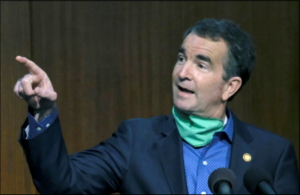Here are a couple of data points to chew on. Yesterday, according to the latest data published by the Virginia Department of Health, Virginia recorded 27 deaths from COVID-19. Of those, 19 occurred in long-term care facilities for the elderly. In other words, 70% of the coronavirus-related deaths occurred in long-term care settings.
That’s just one day’s worth of numbers, but it is not atypical. Over the course of the epidemic, 59% of all deaths were of residents of long-term-care facilities.
By contrast, the big news from Governor Ralph Northam’s Monday press conference was that the Governor will “allow” the City of Virginia Beach to reopen its beaches beginning Friday. But people had better follow the rules, the Governor warned. If they don’t, he “will not hesitate” to slap restrictions back on.
If only there were some way to track how many people contract COVID-19, get hospitalized, and die from frolicking at the beach. The state is in the process of hiring hundreds of contact tracers. It’s not clear yet how they will be used. Perhaps the Governor could deploy some to follow up beach-related infections. That way we could test the proposition, for which there is absolutely no evidence at this point in time, that congregating in the sun and salty air of the beach could reignite the spread of COVID-19.
Meanwhile, we haven’t heard much tough talk from the Governor’s Office about nursing homes, where we know for a fact 614 people have died. Bacon’s Rebellion contributor Jim Sherlock has documented how many nursing homes have fallen short in state inspections, and has shown how even profitable nursing homes have scrimped on staffing. But not one, to my knowledge, has earned a gubernatorial reprimand — or even a warning.
Here’s a thought: If Northam wants to reduce COVID-19 deaths, he should focus state resources on where the deaths are occurring!
That would mean prioritizing nursing homes for the limited supply of state lab testing capacity — targeting facilities where the virus has been identified. It also would mean prioritizing the same facilities for attention by contact tracers. Finally, if there’s any sector of the economy where draconian restrictions and hygienic standards are called for, it’s the confined, hot-house environment of nursing homes. It is imperative to identify the virus and quash it before it spreads.
Perhaps the Governor could dedicate his next press conference to telling Virginians how he plans to halt the nursing home epidemic, which, if yesterday’s numbers are any indication, are continuing without let-up.


Leave a Reply
You must be logged in to post a comment.